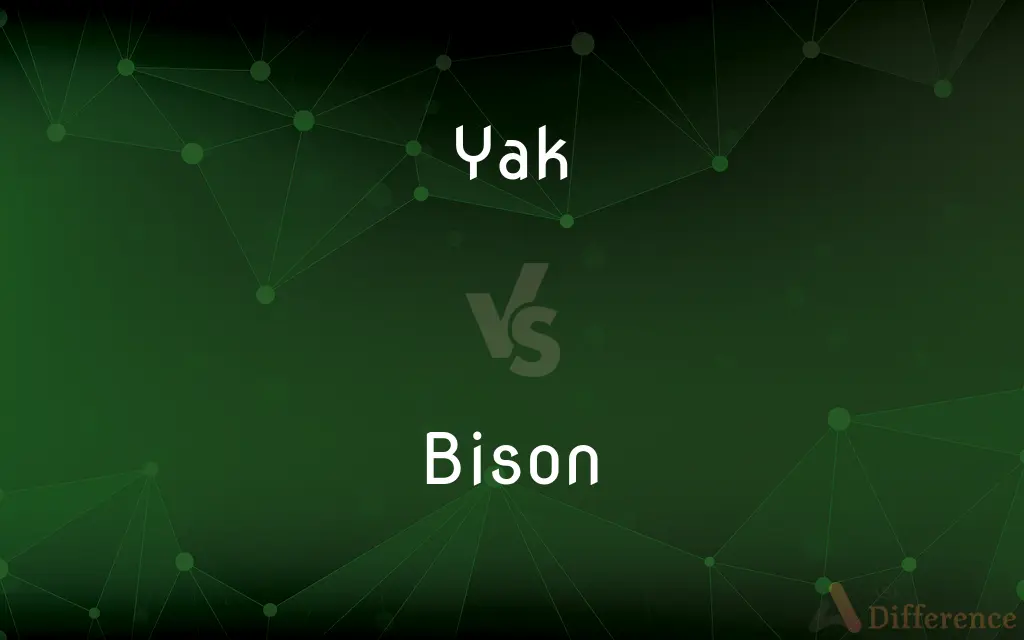Yak vs. Bison — What's the Difference?
Edited by Tayyaba Rehman — By Fiza Rafique — Updated on October 29, 2023
Yaks are long-haired bovines native to the Himalayas, while bison are large, shaggy-haired mammals found in North America and Europe. Both are herbivores, but they inhabit different continents and have distinct physical characteristics.

Difference Between Yak and Bison
Table of Contents
ADVERTISEMENT
Key Differences
Yaks belong to the Bos genus and are indigenous to the mountainous regions of the Himalayas, especially Tibet, Mongolia, and parts of China. These animals are well-adapted to cold climates, with long, shaggy hair and a robust physiology. In contrast, bison are the heaviest land animals in North America, and they roam the plains of the U.S. and Canada, as well as parts of Europe.
Bison, often referred to as buffalo in North America (though they shouldn't be confused with true buffalo), belong to the Bison genus. They are characterized by their broad shoulders, massive heads, and a hump on their upper backs. Yaks, on the other hand, do not have this distinctive hump and tend to have a more uniform body shape with a horse-like tail.
In terms of utility, yaks have been domesticated in Asia for thousands of years, providing milk, meat, and wool to local communities. Their dung is also a vital fuel source in areas where wood is scarce. Bison, once critical to the livelihood of indigenous tribes in North America, were primarily hunted for their meat and hides. However, the overhunting of bison in the 19th century brought them close to extinction.
Another distinguishing feature is the habitat and behavior. Yaks are typically found at higher altitudes and can handle extremely cold temperatures due to their thick fur. Bison are grassland animals, preferring the open plains and prairies. While both animals live in herds, their social structures and behaviors vary based on their environments and needs.
Lastly, the cultural significance of these animals differs. Yaks are deeply embedded in Tibetan culture and religion. They are symbols of endurance and are celebrated in festivals. Bison, on the other hand, hold spiritual and economic importance for many Native American tribes and represent strength and abundance.
ADVERTISEMENT
Comparison Chart
Origin/Location
Himalayas (Tibet, Mongolia, China)
North America and parts of Europe
Physical Features
Long hair, horse-like tail, no hump
Shaggy hair, hump on back, massive head
Utility
Milk, meat, wool, dung as fuel
Historically for meat, hides
Habitat
High altitudes, cold climates
Open plains, prairies
Cultural Significance
Integral to Tibetan culture
Important to many Native American tribes
Compare with Definitions
Yak
A long-haired domesticated bovine native to the Himalayas.
The yak's thick coat protects it from the cold mountainous conditions.
Bison
A species that was once near extinction due to overhunting.
Conservation efforts have been instrumental in reviving bison populations.
Yak
An essential livestock animal in Tibetan and Mongolian cultures.
The annual yak festival celebrates the significance of this animal in the community.
Bison
A large herbivorous mammal native to North America and Europe.
The bison is a symbol of the American West.
Yak
A large animal adapted to high-altitude environments.
The yak can easily navigate the steep terrains of the Himalayas.
Bison
A grazer that roams open plains and prairies.
A herd of bison can quickly transform a landscape through their grazing habits.
Yak
The domestic yak (Bos grunniens) is a long-haired domesticated cattle found throughout the Himalayan region of the Indian subcontinent, the Tibetan Plateau, Northern Myanmar, Yunnan, Sichuan and as far north as Mongolia and Siberia. It is descended from the wild yak (Bos mutus).
Bison
A shaggy-haired bovine with a distinctive hump.
The hump of the bison is a result of strong muscles supporting its massive head.
Yak
A large domesticated wild ox with shaggy hair, humped shoulders, and large horns, used in Tibet as a pack animal and for its milk, meat, and hide.
Bison
An animal historically vital to many Native American tribes.
The bison provided food, hides, and tools for indigenous communities.
Yak
Trivial or unduly prolonged conversation.
Bison
Bison are large, even-toed ungulates in the genus Bison within the subfamily Bovinae. Two extant and six extinct species are recognised.
Yak
Talk at length about trivial or boring subjects
She wondered what he was yakking about
Bison
A bovine mammal (Bison bison) of western North America, having large forequarters, a shaggy mane, and a massive head with short curved horns; a buffalo.
Yak
A wild, shaggy-haired ox (Bos grunniens) of the mountains of central Asia.
Bison
A bovine mammal (Bison bonasus) of Europe, similar to the American bison but with a somewhat smaller head and longer horns; a wisent.
Yak
A domesticated yak, used as a work animal or raised for meat and milk.
Bison
The flesh of the American bison, used as food.
Yak
Prolonged, sometimes senseless talk; chatter.
Bison
A large, wild bovid of the genus Bison.
Yak
To talk persistently and meaninglessly; chatter.
Bison
The aurochs or European bison.
Yak
An ox-like mammal native to the Himalayas, Mongolia, Burma, and Tibet with dark, long, and silky hair, a horse-like tail, and a full, bushy mane.
Bison
Any of several large shaggy-maned humped bovids having large heads and short horns
Yak
(slang) A talk, particular an informal talk; chattering; gossip.
Yak
(slang) A laugh.
Yak
(slang) Vomit.
Yak
(slang) A kayak.
Yak
To talk, particularly informally but persistently; to chatter or prattle.
Yak
To vomit, usually as a result of excessive alcohol consumption.
Yak
A bovine mammal (Poëphagus grunnies) native of the high plains of Central Asia. Its neck, the outer side of its legs, and its flanks, are covered with long, flowing, fine hair. Its tail is long and bushy, often white, and is valued as an ornament and for other purposes in India and China. There are several domesticated varieties, some of which lack the mane and the long hair on the flanks. Called also chauri gua, grunting cow, grunting ox, sarlac, sarlik, and sarluc.
Yak
Noisy talk
Yak
Large long-haired wild ox of Tibet often domesticated
Yak
A herbivorous mammal used for milk, meat, and wool in Asia.
The yak milk is rich and often used to make butter and cheese in Tibet.
Yak
A bovine that plays a key role in Himalayan ecosystems.
Grazing yaks help in maintaining the balance of the alpine meadows.
Common Curiosities
Where can I find yaks in the wild?
Yaks are native to the Himalayas, especially in regions like Tibet and Mongolia.
What's the difference in the coat of a yak and a bison?
Yaks have long, shaggy hair, while bison have a thick, shaggy mane but shorter hair on their body.
What's the average weight of a bison?
Adult male bison can weigh up to 2,000 pounds, while females average around 1,100 pounds.
Are bison the same as buffalo?
No, while bison are often called buffalo in North America, they are distinct from true buffalo species like the African or Asian buffalo.
What predators threaten bison in the wild?
In North America, wolves and bears can pose threats to young or weak bison.
What do yaks eat?
Yaks are herbivores, primarily grazing on grasses, herbs, and shrubs.
Are there domesticated yaks?
Yes, yaks have been domesticated for thousands of years in Asia, providing various resources to local communities.
Is yak milk different from cow's milk?
Yes, yak milk is richer, with higher fat content, and is often used to make butter and cheese in regions like Tibet.
Are yaks and bison related?
Yes, both are bovines, but they belong to different genera within the bovine family.
Can yaks survive in warm climates?
Yaks are adapted to cold climates and may face challenges in warmer environments.
Do yaks have cultural significance?
Absolutely, especially in Tibetan culture where they are integral to daily life and spirituality.
Why are bison significant in American history?
Bison played a crucial role in the livelihoods of Native American tribes and were emblematic of the American West.
How long can yaks live?
With proper care, domestic yaks can live up to 20 years or more.
Were bison ever endangered?
Yes, in the late 19th century, bison were near extinction due to overhunting, but conservation efforts have since revived their populations.
How fast can a bison run?
Despite their size, bison can run at speeds up to 35 mph.
Share Your Discovery

Previous Comparison
Palate vs. Pallet
Next Comparison
Lamb vs. SheepAuthor Spotlight
Written by
Fiza RafiqueFiza Rafique is a skilled content writer at AskDifference.com, where she meticulously refines and enhances written pieces. Drawing from her vast editorial expertise, Fiza ensures clarity, accuracy, and precision in every article. Passionate about language, she continually seeks to elevate the quality of content for readers worldwide.
Edited by
Tayyaba RehmanTayyaba Rehman is a distinguished writer, currently serving as a primary contributor to askdifference.com. As a researcher in semantics and etymology, Tayyaba's passion for the complexity of languages and their distinctions has found a perfect home on the platform. Tayyaba delves into the intricacies of language, distinguishing between commonly confused words and phrases, thereby providing clarity for readers worldwide.














































